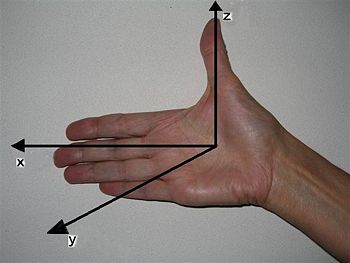Right-hand rule
 From Citizendium - Reading time: 2 min
From Citizendium - Reading time: 2 min
The right-hand rule relates a rotation to a vector perpendicular to the plane of rotation.
Cross product[edit]
The right-hand rule appears in the cross product,
The direction of the unit vector ez given as the cross product of unit vectors along the x- and y-axis is given by the right-hand rule, see photograph.[1]
The case depicted here employs the x- , y- , and z-axis, which normally are orthogonal to each other. However, the rule works for any two straight lines in the xy-plane at some angle α, as long as 0° < α ≤ 180°. If the vector e1 points along one line and it can be rotated in the sense of the fingers of the right hand to align with a vector e2 along the other line, then the direction of the cross-product e1×e2 always is in the z-direction perpendicular to the xy-plane and in the direction of the thumb.
Torque[edit]
A torque is generated by a pair of equal and opposite forces in the same plane, called a force couple. If the right-hand is arranged so the fingers circle in the direction of the couple, the thumb points in the direction of the vector normal to their plane representing the torque, and the magnitude of the vector is taken as the magnitude of the couple. For example, if the forces of the couple are F and −F, and the vector r in their plane separates the two, the couple exerts a torque T = r × F provided r is taken in the direction that makes this cross product point in the same direction as the torque.[2]
Angular momentum[edit]
The angular momentum of a body is related to its motion about a circular path or in turning on its own axis. If the right hand is arranged so the fingers point in the direction of motion, or rotation, the thumb points in the direction of the vector representing the angular momentum. It is normal to the plane of rotation and its magnitude is taken to be that of the angular momentum.[3]
Notes[edit]
- ↑ For example see Paul Charles Matthews (1998). “§1.3 Cross product”, Vector calculus. Springer, pp. 9 ff. ISBN 3540761802.
- ↑ For example, see Andrew Pytel, Jaan Kiusalaas (2009). Engineering Mechanics: Statics, 3rd ed. Cengage Learning, p. 87. ISBN 0495244694.
- ↑ For example, see Paul A Tipler, Gene Mosca (2007). “Chapter 10: Angular momentum”, Physics for scientists and engineers, volume 1, 6th ed. Macmillan, pp. 331 ff. ISBN 142920124X.
 KSF
KSF

